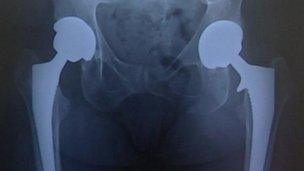Annual checks for patients with all-metal hips
- Published
- comments

The Medicines and Healthcare products Regulatory Agency says 49,000 patients are in the risk group
A huge amount of media attention in recent months has focussed on PIP breast implants, but far less on another potentially faulty device - hip replacements.
Around 70,000 people a year get a new hip and they are among the most successful operations in modern medicine.
But concern has been emerging for some time about certain types of metal-on-metal hips, in particular those where the ball head has a diameter of 36mm or more.
Some 49,000 patients in the UK have these implants and they've been shown to have a much higher failure rate than metal and plastic or ceramic implants.
In addition, the constant wear of the all-metal hip can allow microscopic metal ion particles to enter the bloodstream, potentially causing tissue damage.
The Medicines and Healthcare products Regulatory Agency (MHRA) has issued new advice saying patients with these large head diameter metal-on-metal hips will need monitoring for the life-time of the implant. At present the monitoring stops after five years if the patient has no adverse symptoms.
In future patients will continue to have annual blood tests to check for the level of metal ions - a high level can be indicative of tissue damage around the hip which - left untreated - could make replacement more difficult. If the ion levels are rising then patients will be given an MRI scan to check for damage.
Professor Sir Kent Woods, MHRA chief executive, says these checks should reveal problems early on:
"There is a rough correlation between the pattern of wear of the joint and the level of ions in the blood. We think the ions can at high levels produce local effects on tissue which is why we recommend regular screening so if the levels are high we can recommend repeat surgery at an early stage."
The MHRA said all-metal hips had a failure rate of about 12% after seven years, three times that of metal and plastic or ceramic hips.
It is unlikely to be a coincidence that the new advice comes on the day that a combined BBC Newsnight and British Medical Journal investigation reports that problems with such devices have been long known, but no action taken to block their use. You can see the report on Newsnight at 10.30pm on BBC2.
But Dr Susanne Ludgate, clinical director of the MHRA, says they had first become aware in 2008 of a small number of cases where patients suffered swelling around the hip and tissue damage.
Patients with metal-on-metal hips should be contacted in due course by their orthopaedic surgeon but the MHRA said any patient who was concerned should see their GP.
Professor Sir Kent Woods, Chief Executive, MHRA